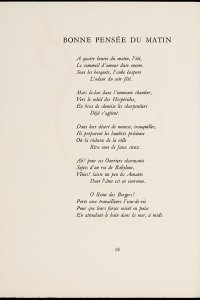Les illuminations
Year: 1949
Author: Arthur Rimbaud (1854 - 1891)
Artist: Fernand Léger (1881 - 1955)
Publisher: Éditions des Gaules
In the short period that Rimbaud was a poet (from age fifteen to eighteen), he underwent an incredible development. His poems are revolutionary, both because of their rebellious tone and because of the way they were written and the new worlds they describe. To Baudelaire's dictum 'Poetry does not have Truth as her goal, but Herself', Rimbaud added 'not even Reality'.
Rimbaud's paintings in verse
To describe those new worlds, he renewed the language, using existing words in a different function and using English loan words. He also renewed the form, as is evidenced by Les illuminations, where he developed Baudelaire's poems in prose. His prose poems are pastiches of other text forms, such as a confession ('Génie') or a short story ('Conte'), but sonnets and other verse return as prose poems too.
Rimbaud's poems are colourful, the most famous example being 'Voyelles', in which he has given a colour to each vowel. According to the title, the visual language and the multitude of colours, Les illuminations were meant to be paintings in verse.
Léger illustrates Rimbaud
Léger took things a bit further and incorporated text by Rimbaud into his compositions. Parts of four poems are used in illustrations, but there are also three poems ("H', 'Elle aimée' and 'Départ') that have neither been printed nor entered in the index, but occur instead as illustrations in the book. Leger has entirely appropriated these poems: leaving out all interpunction, he has written the texts in calligraphy.
The illustrations without text are dominated by primary colours that are typical for Léger. He wanted to bring the colours forward as much as possible and avoided complementary colour contrasts. His figures are often simplified. This does not hold, however, for two illustrations where he seems to have deviated from his usual style. They are the illustrations to 'Bonne pensée du matin' and 'Patience'. The flowers in these two prints are very precise and highly detailed.
![Titelpagina en frontispice van Arthur Rimbaud, Les illuminations (1949): p. [4]-[5]](/sites/default/files/styles/paragraph_small/public/images/les-illuminations-p4-5.jpg?h=5ebcc194&itok=PV_Kr6SB)

![Arthur Rimbaud, Les illuminations (1949), p. [19]: litho van Fernand Léger](/sites/default/files/styles/galerie/public/images/les-illuminations-p19.jpg?h=25d90f2b&itok=QDp1B0sE)
![Arthur Rimbaud, Les illuminations (1949), p. [37]: litho van Fernand Léger](/sites/default/files/styles/galerie/public/images/les-illuminations-p37.jpg?h=71391e74&itok=QJd0qDXm)
